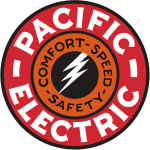| Los Angeles Metropolitan Transit Authority | |
|---|---|
 | |
| Overview | |
| Locale | Los Angeles |
| Transit type | Streetcar Interurban Local bus (including trolleybuses) Bus rapid transit |
| Number of lines | 10 Light rail 2 Trolley bus -- Bus routes |
| Number of stations | -- Rail |
| Daily ridership | -- (Weekdays) |
| Operation | |
| Began operation | July 24, 1951 |
| Ended operation | November 5, 1964 |
| Operator(s) | Los Angeles Metropolitan Transit Authority |
| Technical | |
| System length | Rail – 0 miles (0 km) Bus – 0 miles (0 km) |
| Track gauge | 4 ft 8+1⁄2 in (1,435 mm) standard gauge 3 ft 6 in (1,067 mm) narrow gauge |
| Electrification | 600 V direct current |
The Los Angeles Metropolitan Transit Authority (sometimes referred to as LAMTA or MTA I) was a public agency formed in 1951. Originally tasked with planning for rapid transit in Los Angeles, California, the agency would come to operate the vestiges of defunct private transit companies in the city.
History
[edit]Formed in 1951,[1][2] LAMTA's original mandate was to do a feasibility study for a monorail line which would have connected Long Beach with the Panorama City district in the San Fernando Valley via Downtown Los Angeles.

The agency's powers were expanded in 1954, authorizing it to study and propose an extensive regional transit system.[3] In 1957, another expansion of the agency's powers authorized it to operate transit lines, and it subsequently purchased the bus and streetcar lines then being operated by Metropolitan Coach Lines, which had taken over passenger service of the Pacific Electric Railway in 1953, as well as the bus and streetcar lines of the Los Angeles Transit Lines, successor to the Los Angeles Railway.[4] Both companies, as well as MCL subsidiary Asbury Rapid Transit System, were acquired for $34 million (equivalent to $387 million in 2023).[5] The MTA began operating the lines on March 3, 1958,[6] and continued to do so until the agency was taken over by the Southern California Rapid Transit District on November 5, 1964.[7][8][9][10]
During the MTA's tenure, the last remaining rail transit lines in Los Angeles were abandoned and replaced with bus service, the last former Pacific Electric line in April 1961,[11][12][13] and the last former Los Angeles Railway lines in 1963.[14]
Services
[edit]Rail lines
[edit]| Name | Original company | Abandoned |
|---|---|---|
| Bellflower | Pacific Electric | 1958 |
| Catalina Dock | Pacific Electric | 1958 |
| Long Beach | Pacific Electric | 1961 |
| San Pedro via Dominguez | Pacific Electric | 1958 |
| Watts Local | Pacific Electric | 1959 |
| J | Los Angeles Railway | 1963 |
| P | Los Angeles Railway | 1963 |
| R | Los Angeles Railway | 1963 |
| S | Los Angeles Railway | 1963 |
| V | Los Angeles Railway | 1963 |
Trolley bus
[edit]| Name | Original company | Converted to trolley bus |
|---|---|---|
| 2 | Los Angeles Railway | 1948 |
| 3 | Los Angeles Railway | 1947 |
Bus
[edit]This section needs expansion. You can help by adding to it. (January 2021) |
See also
[edit]References
[edit]- ^ "Here Are Details On Monorail Plan: Group Believes 44-Mile System Can Carry 30,000,000 a Year in Metropolitan Area". Los Angeles Times. July 25, 1951. p. 4. ProQuest 166265189.
- ^ "Warren Signs Bill For Monorail Transit". Los Angeles Times. July 25, 1951. p. 1. ProQuest 166220518.
- ^ "Extension of Monorail Act Sought in New Bill". Los Angeles Times. January 17, 1953. p. 5. ProQuest 166450305.
- ^ "Plan for Public Purchase of Transit Lines Revealed: Legislature Will Get Bill to Legalize Agreements on Sale With Metro and LATL". Los Angeles Times. May 6, 1955. p. 1. ProQuest 166781491.
- ^ Hebert, Ray (17 February 1958). "MTA Plans Faster Service, End to Overlapping Routes". Los Angeles Times. Retrieved 22 January 2021.
- ^ "Transit Authority Begins Operating LATL and Metro: Public Now Owns Big Bus Lines". Los Angeles Times. March 4, 1958. p. B1. ProQuest 167260104.
- ^ Hebert, Ray (May 14, 1964). "Brown Signs Bill Creating New Rapid Transit District: Steps to Replace MTA Will Start Aug. 18; Board to Study Early Bond lssue". Los Angeles Times. p. A1. ProQuest 168614081.
- ^ "MTA Will Reach End of the Line in August: Transit Authority Will Waddle Along as Lame Duck Until New District Takes Over". Los Angeles Times. May 17, 1964. p. B7. ProQuest 168587486.
- ^ Hebert, Ray (October 1, 1964). "Pomona Mayor Named Rapid Transit Leader: New District Board Starts Organizational Groundwork Prior to MTA Takeover Nov. 5". Los Angeles Times. p. A12. ProQuest 155035503.
- ^ "New Agency Takes Over From MTA: Rapid Transit Planners Pledge Solution to Crisis". Los Angeles Times. November 6, 1964. p. OC1. ProQuest 155065465.
- ^ Hillinger, Charles (December 12, 1960). "Big Red Cars to Hoot Final Farewell: Pacific Electric Trains Will Make Last Run April 1". Los Angeles Times. p. B1. ProQuest 167787338.
- ^ "Long Beach Loses Plea for Red Cars: Injunction Denied to Halt MTA Bus Substitution". Los Angeles Times. April 6, 1961. p. B1. ProQuest 167864287.
- ^ Hale, Bill (April 10, 1961). "Passengers in Last Ride on Red Cars: Saddened Patrons Pay $4 Each for Sentimental Trip". Los Angeles Times. p. B1. ProQuest 167886553.
- ^ "Streetcars Go for Last Ride". Los Angeles Times. March 31, 1963. p. N5. ProQuest 168255116.
